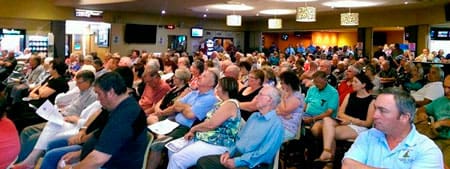Harden and Cootamundra Shire Council have had the door left open to Gundagai Shire Council to join its amalgamation firmly shut, after a 500-strong crowd packed the Gundagai District Services Club on Tuesday night showed strong support to Gundagai Shire Council’s bid to stand alone. However, Council is confident that the Cootamundra-Harden merger proposal will still go ahead without the forced involvement of Boorowa and Young. “Because we have supported the process, I am led to believe that our proposal will be approved,” said Harden Shire Council General Manager, Trevor Drowley. He also believes that a response from the state government will be forthcoming soon after the deadline passes for responses to the Independent Pricing And Regulatory Tribunal’s (IPART) findings on November 18.
At the meeting in Gundagai on Tuesday, a motion put forward by Gundagai Councillor Jim Graham was unanimously supported by Gundagai residents. “The Gundagai community is resolutely committed to retaining Gundagai Shire Council in its current form. The Gundagai community call upon the state government to listen to our community, and not undertake a forced council amalgamation of our Shire,” he said. Council has until next Wednesday to respond to IPART’s assessment that Gundagai is not fit for the future. “At the moment we’re facing the toughest battle to date in terms of retaining our identity,” Mayor Abb McAlister told the crowd. “I know with both my heart and my head that Gundagai Shire Council is fit for the future, and will continue to advocate this.” Cr McAlister said lengthy talks with neighbouring Councils from both Tumut and Tumbarumba, and Cootamundra and Harden, did in no way sway his view that the best outcome for the residents of Gundagai Shire is to remain an independent council. “None of these discussions have convinced that there would be any benefits for Gundagai under a merger,” he said.
Gundagai General Manager Phil McMurray received a rousing applause when he said he believed IPART assessed Gundagai’s submission unfairly and that Gundagai Council is “doing a bloody good job living within our means”. He said the total readily available funds for Council (a combination of working funds and reserve funds) is $8.37 million, with a forecast position in 10 years of $12.59 million. “Our budget is strong, we’re delivering a new main street, we’ve built a bridge at Gobarralong, we’ve got a hell of a lot of money in the bank – how aren’t we financially sustainable?” Mr McMurray said. “The government is set on an agenda to lessen the number of councils in New South Wales because it believes that’ll make it easier for them to operate, but out here things are different, one size doesn’t fit all.” He said to force amalgamations, the NSW Government would need to change legislation which could prove tough to get through the Upper House, with parties greatly opposed to forced mergers. While the boundaries could also be changed through the Local Government Act, this would be a “long and intensive process” before local government elections in September next year.
The General Manager said while it was important to explore mergers with neighbouring councils, the two-hour meeting with Tumut Council “didn’t go very well”. “We got the same government rhetoric – that there will be efficiencies – but they couldn’t show us,” he said. “Both Gundagai and Tumbarumba kept asking the same question, but we couldn’t get a response out of them.” Mr McMurray said a merge with Tumut was not an attractive option for Gundagai, with both Councils having different priorities and objectives, along with the potential for increase of rates. “We spend 17.5 per cent of our budget on roads; they spend five per cent,” he said. “Our average rates are $465; their average is $695.” He did say, however, that discussions with Cootamundra and Harden presented a lot more palatable option.
“They think amalgamations are inevitable and are trying to get on the front foot and merge with a partner of like interests,” he said. Tumbarumba Mayor Ian Chaffey, whose Council was deemed Fit for the Future “under a Rural Council model that doesn’t exist”, pointed to the Victorian Shire of Towong, which was formed in 1994 after the amalgamation of Tallangatta and Upper Murray, as an example of what could happen under amalgamation. “All the senior staff are based in Wodonga, and Corryong is dying on the vine. It’s happening all over,” Cr Chaffey said. “Tumut don’t know of any advantages (to merging), and just look at how well Adelong and Batlow perform under the Tumut Shire. “How do you achieve good governance? It’s about good people who see their community as number one.” Appearing at the meeting via Skype, Dr Joseph Drew, a Research Fellow in the Centre for Local Government at the University of New England who has analysed IPART’s assessment of Gundagai’s Fit for the Future submission, found numerous inconsistencies in IPART’s report.
“When they talk scale and efficiency, they talk population, but population is not the best measure of a council’s scale, and that’s where Fit for the Future went astray,” Dr Drew said. “It’s especially detrimental to country councils who have smaller populations. They have misconceived the fundamental unit for scale.” He said Gundagai is “marginally below the state average for efficiency, and isn’t terribly insufficient compared to the rest of the state”. Nor is Gundagai terribly under scale, according to Dr Drew. The deadline for responses is November 18.

